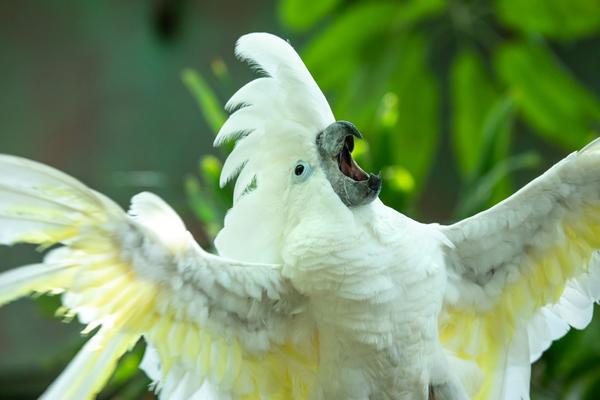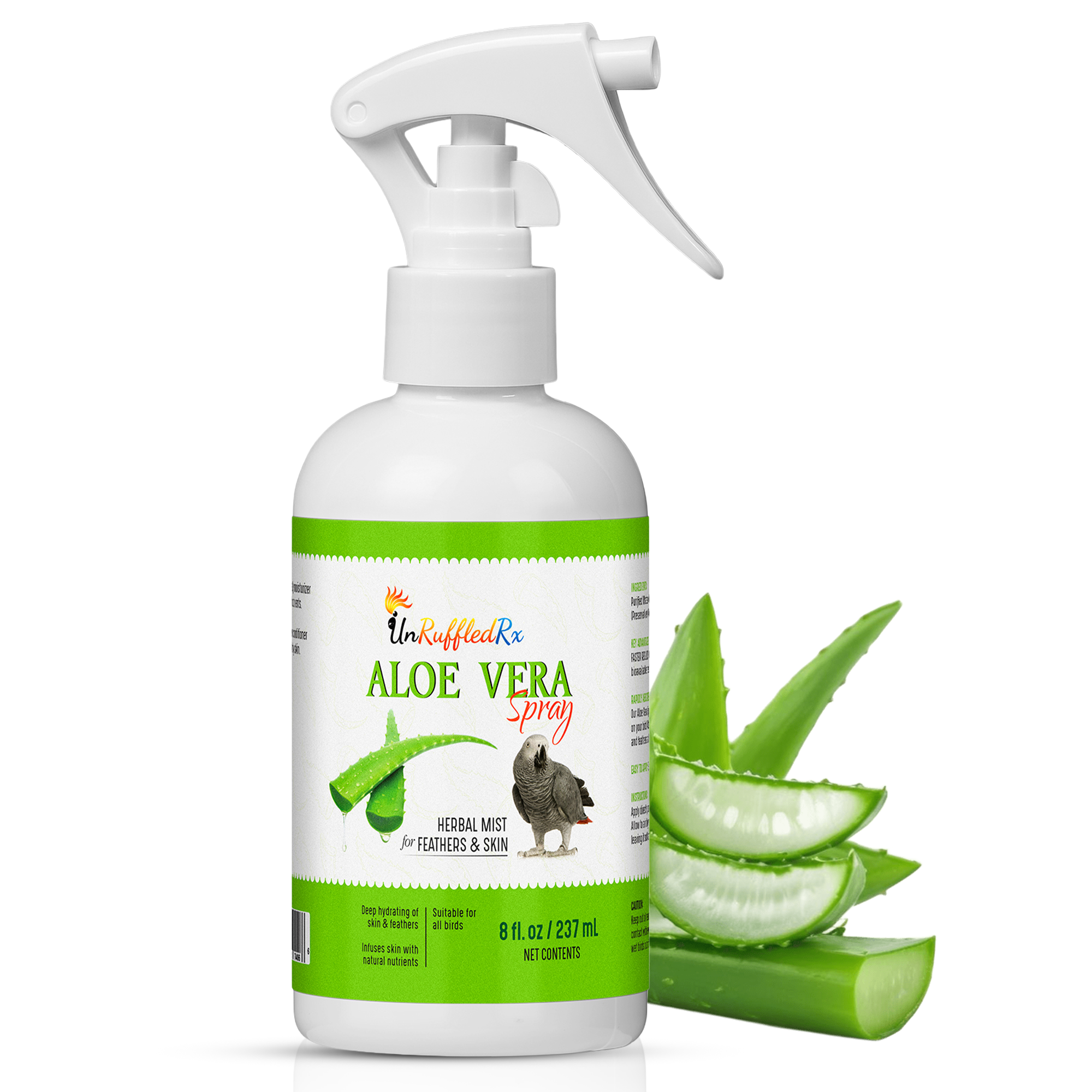Table of Contents
- Can feather plucking be stopped?
- 3 Steps to getting off on the right foot: bird collar, avian wellness, and positive reinforcment
- What Is positive reinforcement?
- Important training strategies using positive reinforcement
- Grab your bird training gear - bird stand, clicker & treats
- Which replacement behaviors you should teach first
- What is an approximation in animal behavior training?
- What are examples of replacement behaviors can I teach so that my bird to stops plucking?
Behavioral issues are unfortunately very common among pet bird owners. One of the most common behavioral problems we see in our practice is feather plucking (also known as feather picking). We receive quite a few calls and emails each month from concerned pet owners who tell us their birds are feather plucking. Sadly, in most cases, people don’t realize just how important it is to fix their bird's behavior at home.
A lot of people think a bird collar will stop feather plucking. This is not true! A bird collar may only interrupt the behavior but it doesn't get to the root cause of why the bird is plucking in the first place. This is why the bird will often resume plucking as soon as the collar is taken off.
In this blog post, I'll discuss how to use behavior training to turn feather plucking around.
Can feather plucking be stopped?
Depending on what’s causing it, there are many different things you can do to try to stop feather plucking. Plucking can be stopped; however, it depends greatly on what’s causing it in the first place and whether you're using science-backed strategies to tackle the problem head on.
As an example, if the cause is a medical disorder, feather-plucking can not be fixed by simply putting a collar on your bird or spraying some sort of chemical on its feathers. You need to support the medical problem with parrot wellness strategies.
It might sound crazy, but it's true. When left untreated, feather plucking can lead to an addictive habit. But don't worry. We know the solutions.
With a dedicated, systematic approach, many cases of feather plucking can be turned around, especially when caught early.

3 steps to getting off on the right foot: Bird collar, avian wellness, and positive reinforcement
First, a bird e-collar helps to discourage plucking in hopes of staving off an addictive habit and allowing skin and wounds to heal.
Second, focus on the 6 dimensions of bird wellness. Get obsessive about it. Over these few short months, it’s essential to maximize the parrot’s health and well-being in every way possible.
Good parrot wellness removes as many potential physical and emotional stressors as possible. Physical and emotional stressors often are at the bottom of a plucking problem.

The third key piece to rehabilitating from feather plucking is teaching your bird safe and healthy replacement behaviors through positive reinforcement. This post focuses on positive reinforcement to help you and your parrot find a happy, healthy, stress-free life together.
As a bird behaviorist with many years of experience working with birds, I can tell you that it’s crucial for parrots (and their owners) to begin their journey towards healing by addressing all three of these areas simultaneously: collar, wellness, and training. This will minimize the possibility of your bird resuming its plucking habit once the bird collar is removed.
What Is positive reinforcement?
In behavioral psychology, positive reinforcement means giving a reward for a desired behavior. Reinforcement strengthens a specific behavior by increasing its likelihood of occurring again in future situations. Positive reinforcement is patient and kind, which always wins a bird over.
Negative reinforcement is taking something away. That's aversive for our birds and it is not recommended because it doesn't work all that well. Neither does punishing your bird. If you really want to change your bird's behavior for the better why not use what works and avoid what doesn't work and use what does work.
Negative reinforcement is demeaning and punitive, which makes your bird lose trust in you.
If you're wondering what you can use to give your bird positive reinforcement, it's best to consider what he likes. Most pet birds enjoy close interaction with their owner, like it when you approach them, talk to them, and pick them up. They love being taught new behaviors. Food treats are a good reinforcer for many pet birds. Some prefer toys or other forms of attention from their owners.
Sometimes in the process of trying to stop the bird from plucking, we’ll go up to our bird and try to console him in some way or another if we see them messing with their feathers. Whether its your reaction or not, there’s something that reinforces the plucking behavior. Often, even punishment can reinforce a behavior.
When using positive reinforcement to stop plucking you switch gears and focus on the behaviors you want to see more of rather than focusing on the undesirable behavior. Start by asking your self ‘what behaviors do I want to see more of,’ then start reinforcing these behaviors. That's teaching your bird replacement behaviors and extinguishing behaviors that you don't care for.
Take a moment to think of a few safe behaviors that you'd like to see your bird do more of, whether it's a cute little trick, foraging, or stepping up on command. Next, I'll talk about how to use positive reinforcement to teach your bird replacement behaviors.
Important training strategies using positive reinforcement
The first step in training a bird is identifying your target behavior. A target behavior is the behavior that you want your bird to change.
A replacement behavior is one that you teach your bird to do instead of his or her problem behavior.
For example, if a nervous parrot is plucking, he or she can be taught to forage as one new way to calm itself down.
Teaching replacement behaviors is way easier than you think. For example, if your bird is plucking as a way to calm anxiety, you can teach it to play and forage instead.
Once you've identified a few replacement behaviors, it's time to set you and your bird up for success.
1. Find a favorite treat that your bird is begging for. Break it into small pieces that can be eaten in just a second or two. This helps keep training sessions engaging and fast-paced.
2. Break the behavior down into small chunks so it can be performed quickly. The idea is to elicit a small approximation of the behavior, mark it with a "click", and reward it quickly. Repeat until the new behavior is now a new habit.
3. You can expect to make rapid progress towards developing new, safer habits in as little as 5 to 15 minute training sessions, just twice a day.
4. Figure out the cue for the behavior that you're teaching. This could be a verbal or hand cue. that tells your bird. "Hey, do this behavior now."
5. Once the bird does the expected behavior give it a bridge. This is how you tell your bird "good job!" A lot of people use clickers. Others use an animated word or phrase, "Good job buddy!"
Why is this training method so effective? First, your bird thrives on the positivity of it. You are only reinforcing the specific behaviors you want to see more of and you are ignoring the rest. It takes out any confusion that the bird may have.
Plus, your bird is getting much more than a favorite treat. It's enjoying quality, enriching time with you while learning what behavior gets him what he wants.
Grab your bird training gear - bird stand, clicker & treats
Next, grab some bird training gear.
A training stand: Choose a T-stand that has no distractions like food dishes or toys. You want your bird to associate the training stand with “education” just like a kid associates a school desk with learning.
A Clicker: Are you tired of working your fingers to the bone to get your pet bird to stop plucking their feathers?
Then try this proven method! Studies show that rewarding birds with treats is a lot easier with a clicker! Just teach your bird that every time they hear a click, they get a tasty treat.
Load the clicker by showing them every time they hear a click, they get a special treat. Now, pair the treat with a specific behavior. The positivity of clicker training helps a nervous bird to engage in training.
A treat bag: A favorite treat, and a quick way to administer it, helps speed up the training process. Clicker training relies on providing a short reward and repetitive reinforcement. The treat must be small enough to be eaten in just two or three seconds. You are basically helping your bird develop a new “go-to” habit that replaces the plucking habit.
Which replacement behaviors I should start teaching first?
To help you decide which behavior to teach first, try and work out what exactly triggers feather-pulling episodes in the first place. Is your bird nervous and easily alarmed? Is he overly obsessed with feather-pulling to get attention? A behavior assessment will help you figure out the trigger.
If your bird needs to calm its anxieties to benefit from training, reinforce any resemblance of calm behavior. Start small, like the bird allowing you to give a treat from a long handled spoon without a meltdown. Picture yourself slowly moving closer and closer over time until the bird is taking the treat from your hand. Now the bird isn't so scared of your hand anymore.
You're teaching your bird that he gets rewarded for letting your hands come in close proximity - that your hands are a good thing. And you're also teaching him how to calm himself down! And, that nervous behavior doesn't get him anything. You'll love it when you see your feathered friend pet you for a change.
Likewise, when you have a bird so obsessed with plucking feathers that it cannot pay attention to training, start by clicking and rewarding in the shortest amount of time — like not plucking for 2 seconds. Work your way up until your bird can go several minutes without compulsively plucking.
You'll love it when you see your feathered friend's compulsive habit fade away. Learn how to reward your bird for giving you his attention rather than focusing on its feathers. Plus, teach him how to calm himself down by focusing on you rather than plucking a feather!
What is an approximation in animal behavior training?
A successive approximation" involves changing one's behavior in small steps - each closer a long-term goal. Tiny, incremental changes can make all the difference in the world. Think of it as reshaping the original, unwanted behavior into a safe, pleasant behavior.
So if I want to teach my bird how to put a ball in a pint-sized basketball hoop, I’ll have to teach each of the following:1. To simply look at the ball
2. To approach the ball.
3. Touch the ball.
4. Pick up the ball in its beak.
5. Hold the ball in its beak.
6. Hold the ball in its beak and take one step.
7. Then take two steps.
And so on until it finally places the ball in the basket as if he's a feathered basketball player.
Each one of these steps can be taught fairly quickly. You feel success, and equally important, your bird feels success. Just imagine how happy everyone is when you have a plan that works! It helps to write this plan down so that you can pace the training without getting burned out.
What are examples of replacement behaviors can I teach so that my bird to stops plucking?
Check out these 3 types of bird training that will help turn around unwanted behavior in parrots.
Bird Tricks or using props - Feather plucking is frustrating for you and your bird. But with some exciting training and some delicious treats, your feather plucking bird will be able to play basketball, put a ring on a peg, or wave hello. The self-confidence that your bird gets from successfully learning tricks may lead them to stop plucking.
Manners - When training your parrot, why not use a tried and true technique of positive reinforcement training? When your parrot gets positive reinforcement for their good manners, they're more relaxed. They know what's expected of them - good, safe behavior. Good manner training like coming out of and going into the cage, stepping on a stick, and "drop it" has helped many people make their birds more calm.
Natural Parrot Behaviors - Who knew that you had to teach your hand-fed bird natural parrot behaviors? Wild parrot parents spend a long time teaching their young how to forage for healthy food, how to groom their feathers, beak, and nails and more. Our hand-fed birds may never have learned these skills so they end up feeling bored all day - a situation that can lead to unwanted behaviors. Train your bird how to forage, how to play with toys, how to bathe, and how to eat veggies.
Related Posts:
6 Essential Dimensions Of Parrot Wellness You Need To Boost Today
Huggle Neck Collar Size Guide
What to Look for in a Bird Collar for Parrot Plucking
Neck Collar Size Guide
References:
Friedman, S. Empowering Parrots: Positive reinforcement boosts confidence for both bird and trainer. Bird Talk Magazine. November 2005, pp. 30-34.
Heidenreich, B. An Introduction into Positive Reinforcement and Its Benefits. AFA
Watchbird. pp. 13-21.
Joseph, L. Reinforcing Behavior With Attention & Petting. 2014.
O'Heare, J. Resolving Fears, Phobias, and Anxieties: An Errorless Differential Reinforcement Approach For Professionals. BehaveTech Publishing, Ottawa, Canada. 2018.
Roberts, S. Petting and stroking parrots. IAACB Journal.
Diane Burroughs, LCSW is a licensed psychotherapist trained in ABA therapy techniques. She specializes in avian anxiety disorders and is certified in Nutrition For Mental Health. Diane has written a number of bird behavior books and she offers behavior consultations. She's developed a range of UnRuffledRx Science-backed Parrot Wellness Supplies.
Diane's products have been featured in the Journal of Avian Medicine and Surgery and at Exoticscon, a conference for exotic pet veterinarians. Her bird collars & supplements are stocked in avian vet clinics and bird stores throughout the US. With over 30 years in the field of behavior, Diane has created thousands of successful individualized behavior plans that help pets thrive.
TAGS: #PositiveReinforcementTraining #PositiveReinforcmentandPlucking
SHARING IS CARING! PLEASE SHARE ON YOUR FAVORITE SOCIAL MEDIA NOW!














